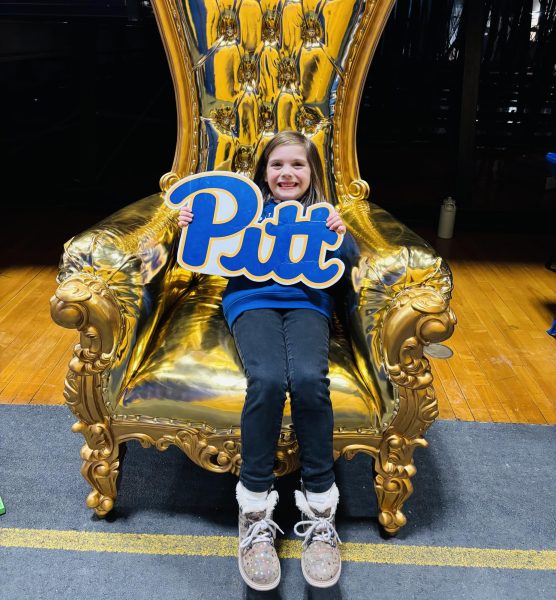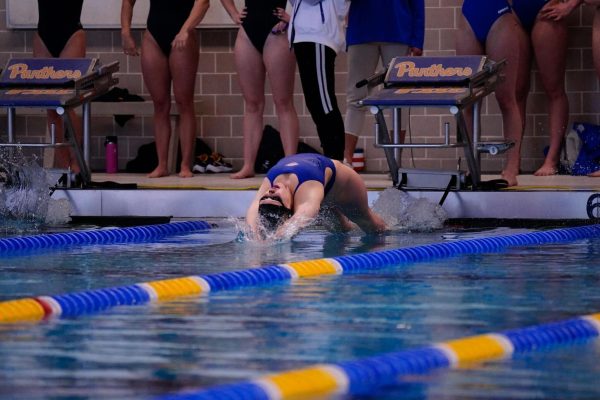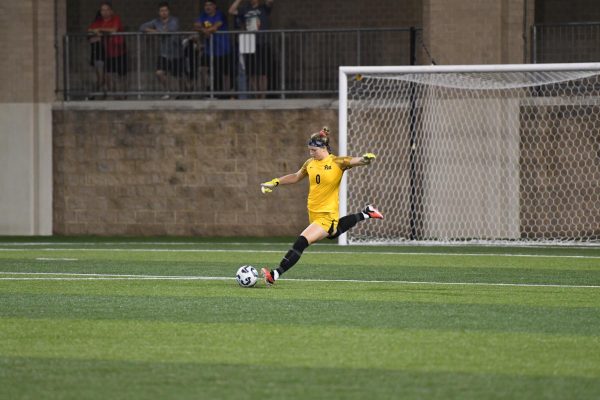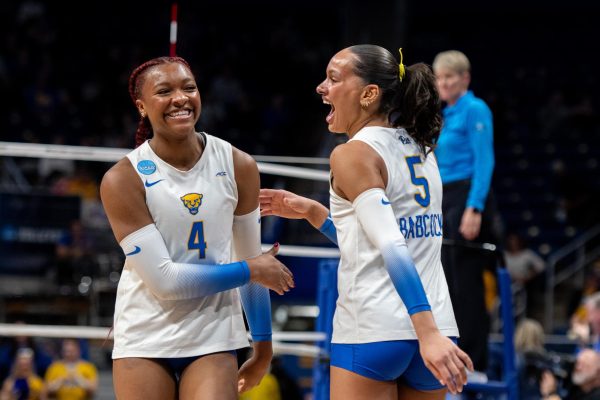Young women have something now that was not even comprehensible 52 years ago, when Title IX was initially passed — they have women role models in sports.
These young women can go to a sporting event at Pitt and see athletes like junior opposite hitter Olivia Babcock play volleyball in front of sellout crowds and say to themselves, “I can do that someday.”
This isn’t something that has always been possible.
Jane Molina, who swam breaststroke for Vanderbilt in the 1980-1981 season, had the seniors on her high school team to look up to, and that was really it. She didn’t have any female athletes to follow suit.
Even when Molina made it to the collegiate level without having these role models to look up to, it didn’t get better for her. The men on the swim team felt as though their scholarship money was taken away and given to someone less deserving.
But Molina wasn’t a slouch in her one year with Vanderbilt — she made nationals and was one of the best swimmers in the program. Despite her success, the “jealousy” in the program regarding her scholarship tainted her achievement and made her feel “oppressed.”
As a result, she transferred to St. Louis. She was no longer a scholarship athlete but had renewed her love for swimming.
Finding role models
The negative experiences Molina dealt with at Vanderbilt didn’t hinder her love and support for women’s collegiate athletics. She makes sure her granddaughter, Florence “Flo” Molina, goes to every possible women’s sporting event at Pitt. Flo has watched Pitt gymnastics, women’s basketball and swimming.
“I want [Flo] to see women competing in a collegiate level as a little kid,” Molina said. “Her to have that exposure, to go to games and see girls competing at the highest level that she’s going to have exposure to.”
But Flo isn’t the only young girl idolizing female athletes at Pitt. Pitt volleyball has even influenced a number of young girls playing volleyball in Western Pennsylvania.

(Courtesy of Jane Melina )
“Parents have come up to me and been like, ‘Oh, my daughter was watching your game and she decided to sign up for volleyball, and she’s coming to camp,’” Babcock said.
It’s a role reversal for Babcock. She was once the girl who started playing soccer and gymnastics because of who she saw on TV. But it’s not just TV that these girls see these athletes anymore. Social media is one of the easiest ways for young girls to see their role models in sports.
“They get to peek more into our lives, which didn’t used to be a thing when I was younger,” graduate student outside hitter Cat Flood said. “I was never looking at some college athlete’s Instagram and being like, ‘Oh my gosh, I want to be her.’ But I know that these girls are doing that and thinking they want to be just like us.”
The thing that makes girls gravitate towards Flood is that she tries to differentiate herself from the “cookie-cutter student-athlete.” She’s willing to go against the norms and is not “trying to be perfect.” Flood has her signature two-tone hair, something not many collegiate athletes are willing to try out.
Junior goalkeeper Ellie Breech’s role model growing up was similar to how Flood acts. Neither Flood nor Breech’s role model stuck to the norm.
“[Serena Williams] is strong, she’s fierce, she’s dominant,” Breech said. “She breaks the stigma of athlete body types a little bit too. She’s more about having your body for sport, not for looks or views or anything.”
Unlike Breech, junior swimmer Claire Jansen doesn’t have to look far or across another sport for her role model — she turns to her teammates to use as role models.
“What has inspired me is Sophie [Yendell] on our team. Sophie was the first woman in a while to achieve All-American status,” Jansen said. “Coming in my freshman year and having her as a role model was great, and she definitely propelled me to qualify [for nationals] for my freshman year, and she’s just always been an inspiration for our team.”

(Jonathan Guo | Staff Photographer )
Having Yendell to look up to helped Jansen achieve All-American status earlier this year in March. Role models like Yendell and Pitt head coach Chase Kreitler are very supportive.
“Our coach is a great women’s coach. He knows how to coach girls,” Jansen said. “He treats his job with such emotion. It really helps to have that.”
Pitt volleyball assistant coach Kamalani Akeo understands that her role is similar and it isn’t just to coach — although that is still important to her. She knows she’s a role model for people like Babcock and Flood to look up to.
She’s donned the Pitt volleyball uniform, played for head coach Dan Fisher and in the NCAA Tournament, and dealt with the stresses of managing your time as a student and a collegiate athlete.
Finding success
In her gender in sports class, Babcock was looking through Pitt’s old yearbooks. She noticed that in the 1970s, Pitt didn’t have women’s sports at all. Now, not only does Pitt have them, but its investment in women’s sports has skyrocketed.
The most drastic growth is in volleyball. Six or seven years ago, players could only dream of seeing the crowds and media attention the team brings now. The program went from barely selling tickets to selling out almost every game.
“It’s the new normal at this point,” Akeo said when she compared her time coaching now for Pitt to playing from 2015 to 2018 for Pitt.
While other women’s programs aren’t quite at sellouts being “the new normal,” viewership has noticeably increased across female sports in general, thanks to a heightened talent pool. Akeo is recruiting more “elite athletes” year in and year out because of this growth in talent.
Women’s soccer went from celebrating hitting 10,000 followers on Instagram three years ago to actually seeing the bleachers fill up. The team also spends 20 minutes after games to compensate for the number of fans waiting for autographs and photos, compared to the handful of fans they had before.

(Grace Longworth | Contributing Editor)
Just a few years ago, the All-American accolade was gathering dust on the women’s swim trophy shelf, but after this season, two female teammates earned that status for the first time since 1995.
Pitt women’s track garnered media attention as well. Women’s sprinter Je’Nyia Burton broke two school records so far this season — her most recent at the NCAA Indoor Championships. Burton crushed the previous 400-meter dash record and ran a 51.82.
Ultimately, Burton transferred to Pitt for her senior year to fulfill one goal.
“I told [coach Webb] I want to run a 49,” Burton said. “He was like, he’s never coached anyone that could run a 49, but if I had the mindset … then his training could get me there.”
Finding new opportunities
Exposure to athletes like Burton has done more than just draw more attention to women’s sports in general. Title IX’s impact has trickled down to the next generation of female athletes.
“There’s these little babies full on doing serve receive drills,” junior outside hitter Blaire Bayless said, recalling a visit home to her old volleyball club. “It’s really cool to see how early the game is being developed.”
Some Pitt female athletes came into their sport much later in their lives and still perform at an elite level. This generation of college athletics has yet to see kids who have played since early childhood. These young female athletes get to watch professional female athletes in America rather than having to dive deep into YouTube to see them compete.
“Now that we have the professional leagues in the States. I think [the level of play] is only going to improve even more because kids are going to grow up watching our Olympians play right here,” Akeo said “They’re going to be watching their role models who two years ago would be playing in, like, Poland or Russia … but now it’s just like right next door.”
Since PVF and LOVB — the two volleyball leagues in America — were founded, Pitt volleyball has sent multiple athletes to the teams, including Rachel Fairbanks and Valeria Vazquez Gomez from Pitt’s 2024 roster.

(Liam Sullivan | Senior Staff Photographer)
But volleyball isn’t the only sport that has made its way to the professional ranks in America. Pitt produced several professional soccer players within the past year. The most recent was forward Sarah Schupansky, who entered the NWSL — the professional women’s soccer league in America — in mid-March.
Pitt female athletes are seeing the professional league more, which in turn generates more support for their sport.
“It just makes me so happy that more and more young women … are watching Pitt women’s soccer and falling in love with the game just as much as I did,” Breech said.
Finding room for improvement
Despite the desire to create multiple professional women’s leagues and the large improvement since Molina’s time in college, a stigma that persists in female sports is the double standard of competitiveness. Women’s competitive behaviors are often perceived differently compared to their male counterparts, and that’s something female athletes experience at every level.
“I feel like women’s volleyball and women’s basketball get a lot of hate for some reason,” Babcock said. “And I want people to know that, yeah, we might be female athletes, but we’re putting the same amount of time and work into this stuff, and we’re people, and I don’t think we should be treated any less than.”
According to an article by Forbes, the stigma stems from the societal expectation that women should exhibit femininity, whereas competition is deemed a masculine attribute. When female athletes don’t meet this expectation, it leaves them open to more criticism. Ultimately, it’s a lose-lose situation.
“Competition is about intensity, being aggressive, who’s the bigger dog. And if you’re not competitive, put your game face on a girl,” Flood said. “The thing about being a woman in sports is showing your strength.”
Competition is designed for aggression, but women can’t show aggression if they don’t want to receive criticism. They have to compete hard enough for critics to deem their sport entertaining. This balancing act is another challenge female athletes face and misses the point of the sport entirely.
Women athletes at Pitt continue to navigate this double standard by showing how competitiveness is not exclusive to men.
“I love watching people be competitive. I love watching people put their game face on,” Flood said. “We do a lot of game day hair, game day makeup, game day routine. But it’s all to just leave it all out there on the court.”
The post ‘The new normal’: Pitt athletes reflect on changing landscape of women’s sports appeared first on The Pitt News.